sensor VOLKSWAGEN GOLF MK5 2006 User Guide
[x] Cancel search | Manufacturer: VOLKSWAGEN, Model Year: 2006, Model line: GOLF MK5, Model: VOLKSWAGEN GOLF MK5 2006Pages: 444, PDF Size: 92.7 MB
Page 134 of 444
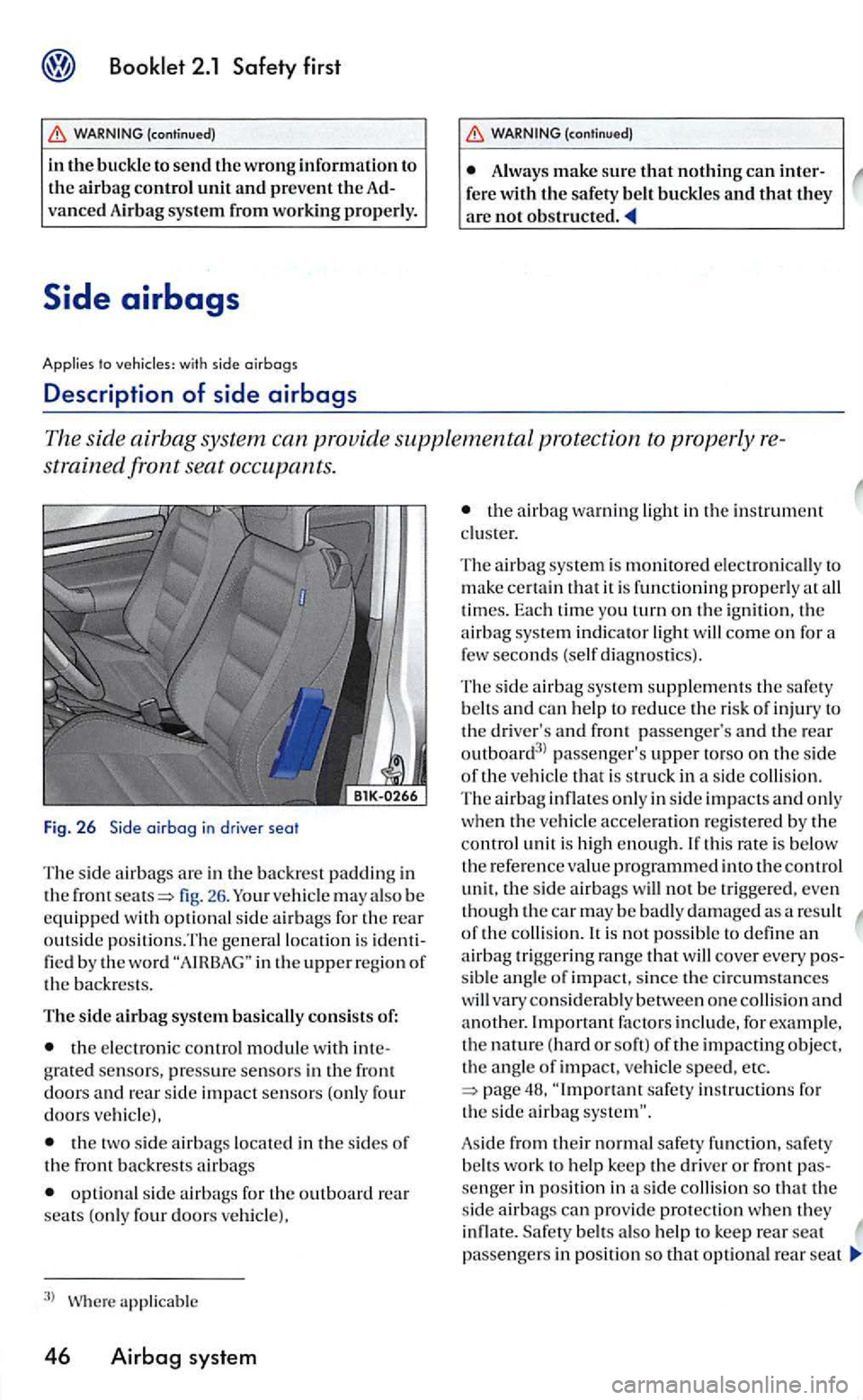
to vehic les: with side airbags
Description of side airbags
Always make sure that nothing can inter-fe re with the safety be lt buckles and that they are not
The sid e airbag system ca n provid e supplemental protection to properly
strain ed fron t seat occupant s.
Fig. 26 a irbag in drive r seat
The side air b ag s are in the backr est p addin g in the fig. 26 . ve hicl e m ay als o b e
equipped w ith optiona l sid e ai r bags for the re a r
outs id e po siti ons.Th e ge nera l lo cat io n is in the upper regio n of the backrests .
The side airbag system basically consis ts of:
the e lectroni c co ntro l module with grated sensors, pre ssure sen so rs in the front doors and re a r s ide impact sensors (only four doors ve hicle).
the two side airbags locate d in the s ides of the fro nt backre sts a ir ba gs
opti ona l s id e a irbags for the outboard rear seats (only four door s ve hicle).
3) W here ap plicabl e
46 Airbag system
the airbag warning light in the in strument clu ster.
The airb ag syste m is monitore d electroni cally to make certain that it is fun ctioning properly at all times. Ea ch time you turn on th e ig nition, the
a irba g syste m indi cator light will come on fo r a
few s e conds (self diagnostic s).
Th e side
airbag s ys te m supplements the s afet y
b elt s and can help to reduce the ris k of injury to the dri ver's and passenge r's and the rear
outboard3> passen ge r's upper to rs o on the s ide
o f the ve hicl e that is st ruck in a s ide colli sio n. The a irb ag infl ates onl y in sid e impacts and o nl y
w he n th e ve hicle accele rati on r egis te re d by the
co ntrol unit is hi gh enough. If thi s rate is be lo w
th e re fe re nce valu e progr ammed into the control unit. the s ide airb ags will not be tri gge re d , ev en
th oug h the car m ay be bad ly da m ag ed a s a re su lt
o f the c ollis ion .
sib le angle of impa c t, s ince th e c ircumsta nce s
will v ary consid era bly betw een one collisio n and ano ther. Important fac tor s includ e, Fo r e xample, the nature (hard or soft) oft h e impacting o bject, the ang le of impact, ve hicl e speed, e tc . s afe ty in stru ctions fo r the sid e a irbag
Aside from their normal safety function, sa fe ty
b elt s work to he lp keep the driver or front se n ge r in po sition in sid e co llision so that the
s ide airb ags c an pro vid e pro tection whe n th ey
inflate. Safety belt s als o help to keep rear seat
passenge rs in pos ition so tha t opti onal seat
Page 139 of 444
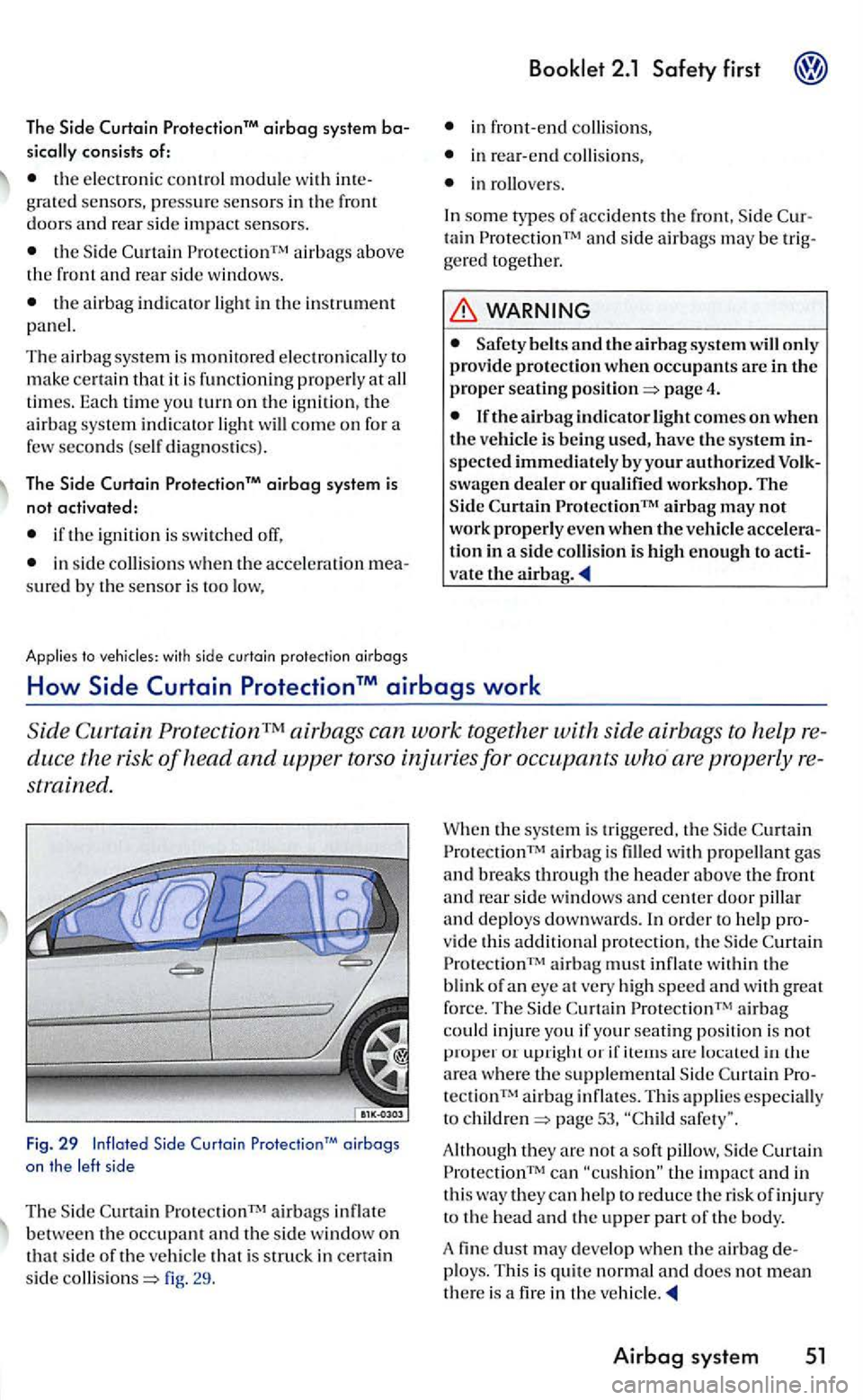
The Protection'M airbag system
consists of:
the elec troni c control module with grated senso rs, press ure sensors in the doors and rear side impact sensors.
airbags above the front and rear side w indo ws.
the ai rbag
Protection airbag sys te m is not activated:
if the ignit ion is sw itched off,
in sid e collisio ns w he n the acceleratio n sured by the senso r i s too low,
Applies t o vehi cles: w ith side curta in protection oirbogs
Booklet 2.1 Safety first
in front-end collisio ns,
in rear-end collision s,
some types of accidents the fron t, Sid e tain ProtectionTM side airbag s m ay be
Safety belts and the airhag syste m will only
provide protection w hen occupants are in the proper seating page 4.
spected immedia tel y by you r authori ze d
tion in a side co llision is hig h enough to vate the .
How
duce the risk of head and uppe r torso injuries for occupants are properly
strained .
Fig. 29 airbogs on th e left sid e
Th e Sid e airbag s infl ate
b etween the occupant a nd the si de window on
that sid e of th e ve hicl e is struck in certain
s ide fig . 29 . When
the sys
te m is tri gg ered, the Sid e airba g is fille d with propellant gas
and break s th roug h th e header above the front and rear sid e window s and center d oo r pillar and deploys dow nwards. In order to help v ide thi s additional prote ction, the S ide ProtectionTM airba g must inflate w ith in th e
b lin k of a n eye at very high speed and with great force. The Sid e Protectio nTM airba g
co uld injure you if your seating posit io n is not proper o r upright or if area where tec tion TM a irbag in fla tes. T hi s appli es especially
t o page 53,
the impact and in
th is way they can help to reduce the risk o f injury
t o th e head and the upper part o f the bo dy.
A fin e dust m ay deve lo p w hen th e a ir b ag ploys. This is quite norm al and does n ot mean
th ere is a fir e in th e ve hicl e .
Airbag sy ste m 51
Page 143 of 444
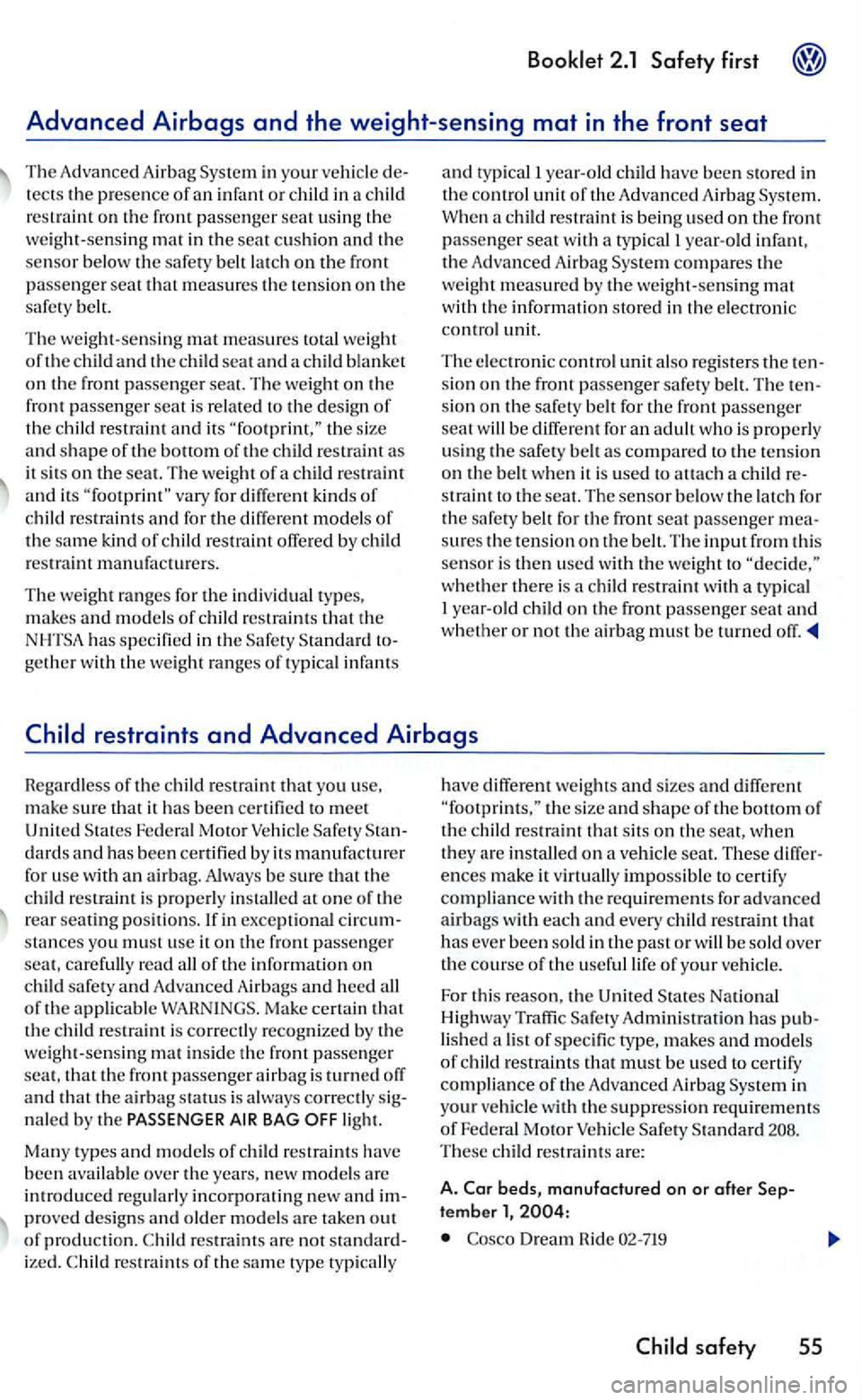
2.1 Safety first
child on the front passe nger seat u sing th e weight-sensing m at in the seat c ushion and the sen sor below the safety belt latch on the front
p assenger seat that measures th e tension on the safe ty be lt.
Th e we ight -sensin g
mat measures to tal weight of the c h ild and th e child seat and a chi ld blanket on th e front passeng er seat. The weight on the
front pas s enge r seat is re lated to the design of th e c hild restraint and its the size and s h ape of the bo ttom of the chil d restr aint as
it sit s on the seat. The w eight o f a child restraint and its
manufacturers .
T he
weight ra nges for the indi vidual types,
m akes and models of child restr aints that th e
N HTSA has s pecified in the Sa fe ty Standard gether w ith the weight r a n g es of t ypical infan ts a
nd ty
pical I year-old child have been in
th e control unit of the Adva nced Airba g Sys te m.
When a child restraint is being used on the front passenger seat w ith a typic al! year-o ld infant ,
th e Ad va nc ed Airbag System compares the weight measured by the weight-sensin g m at
with the informa ti on stored in the electro nic
control unit.
T he el
ectroni c control unit als o registers the s ion on th e front passenger safe ty belt. The sion on th e sa fe ty belt for the front passenge r
seat w ill be differe nt for an adult who is properly using the sa fety belt as compared to the te nsion on th e belt when it is used to atta ch a child strain t to the seat. Th e sensor below the latch for the sa fet y belt for th e front seat passenger sures the tension on th e belt. The input from this
se nsor is then u sed w ith the weight to w he th er there is a child restraint with a ty pical
I year-o ld child on the front passenger seat a nd
w hether o r n ot th e airba g must be turned off .
Safety dards and has been certified by its m anufa cturer
f o r use with an airbag. Alwa ys be sure that the chil d restraint is pro perly in stalled at one of th e
rear seating positi ons. If in exce ptional sta nces you must use it on the front passe nge r seat, carefully read all of the information on child safety and Ad vanced Airbag s and heed all of th e a pplic abl e WARNINGS. Ma ke certain that
t h e c hild res traint is correctly recognized by the
we ig ht-sensi ng mat in side the front passeng er seat, that th e fron t passenger a irb ag is turne d off and that the airbag statu s is alw ays correctly naled by the BAG light.
Man y ty
pes and model s of c hild restrain ts hav e
been availabl e ove r the years . new mode ls a re introduced reg ularly incorporating new and prove d desig n s and older mod els are take n out of production. res traint s are not iz ed. re s traint s of th e same type ty picall y h
ave diff e
rent weig hts and sizes and diff erent the size and s hape of the bottom of
th e child res traint that sit s on the seat, when they are in stalled on a seat. These ences make it virtu ally impossibl e to certify compliance with the require m ents for advanced
airbags with each and every child restraint that has ever been so ld in the past or w ill be s old ove r
t h e course of the useful life of your
For thi s rea son, the United States National High way Traffi c Sa fety Adm ini strat ion has lis h e d a list of s p ecific type, makes and m od els of c hild restraint s that must b e use d to certify compliance of th e Advanced Airbag System in
your ve hicle with the suppression requirements of Federal Mo tor These child restraints are :
A. Car beds, manufactured on or after tember 1,
Dream Ride 02-719
safety 55
Page 299 of 444
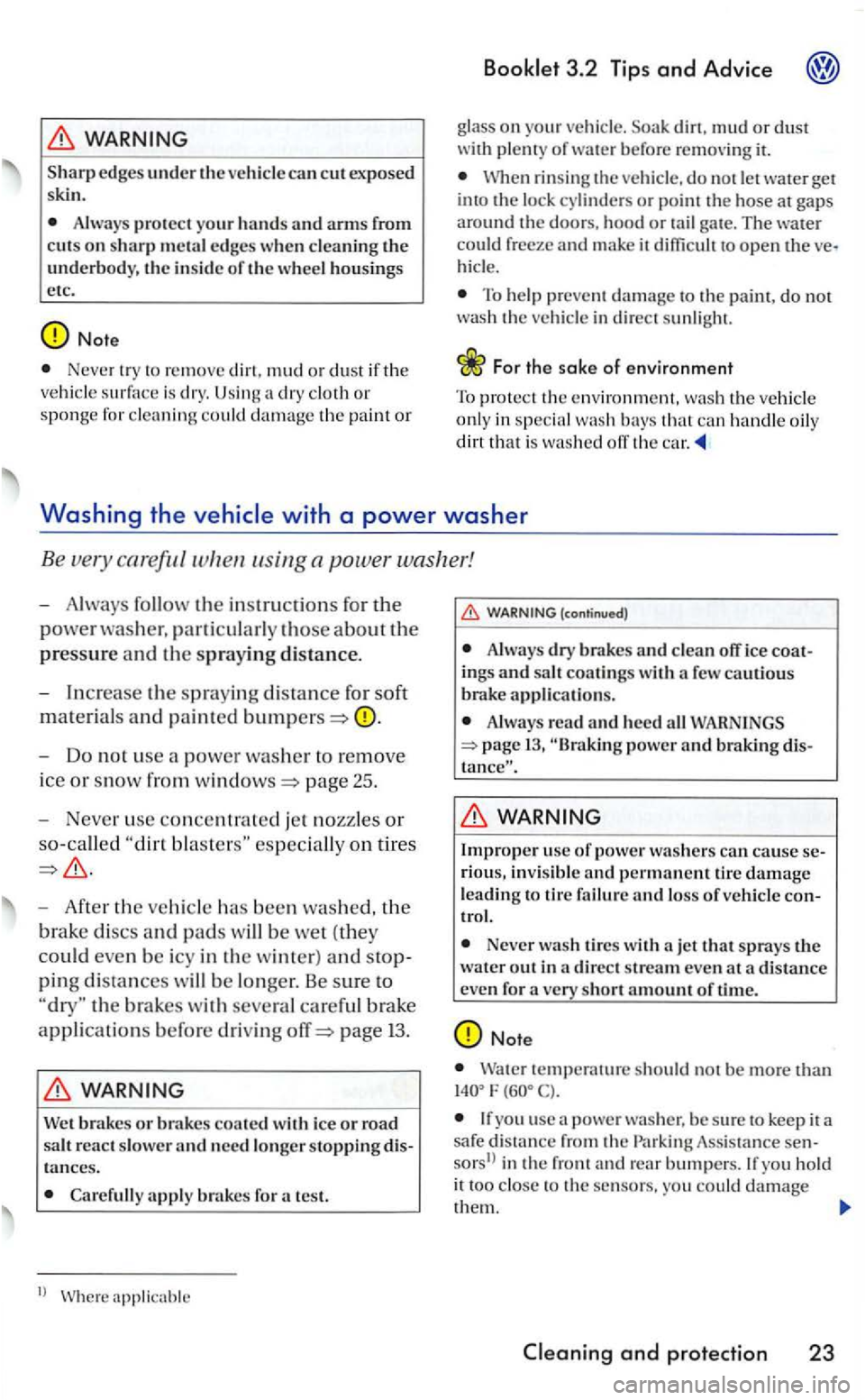
edges under the vehicl e can cut exposed
ski n.
Alway s protect your hands and arms from cuts on sharp m etal edges when clea ning th e underbody, the inside of th e wheel housin gs
etc.
Never try to remov e mud or dust if the vehicle dry . a dry cloth or
sponge fo r cleaning could damage th e paint or
3.2 Tip s and Advice
glass on your vehicle . dirt . mud or dust with plent y of wate r before removing it.
When rinsing the vehicle. do no t let water ge t
int o th e lock cylinders or point the hose at gaps
around the doors. hood or tail gate. The water could freeze and make it difficult to open the hicle.
To he lp preve nt damage to th e pai nt, do not was h the vehicle in direct sunl ight.
F o r th e sake of environment
To protect the environme nt. wash the vehicle
only in specia l was h bays that c an handle oily
d irt that is wash ed off th e car.
- Do nor use a power washer to remove
ic e
or snow page 25.
- Neve r use concentrated jet nozzles or
so-called
- After ve hicl e has been washed, the
brake
dis cs and pads will be we t (they
could even be icy in the win te r) and
th e brakes with seve ra l care ful brake
application s before drivin g page 13.
WARNING
brakes or bra kes coa ted with ice or road salt react slower and n eed longer stoppin g tances.
Ca re full y apply brake s for a test.
1
l ap plicab le
Always dry and cl ean off ice ings and salt coatings with a few cautious brake applicati ons.
Always rea d and heed all power and braking
WARNING
Improper usc of powe r was he rs ca n cause rious , in vis ible and perm an ent tire damage leading to tire failur e an d loss of ve hicle trol.
Never wa sh tire s wi th the water out in a direc t stream even at
temperature sh o uld not be more than F
If yo u use power wash e r. be sure to keep it a
sa fe d istance from the sors' > in the front and rear bumpers . you h old
it too to the sensors, you could damage
them.
and protection 23
Page 308 of 444
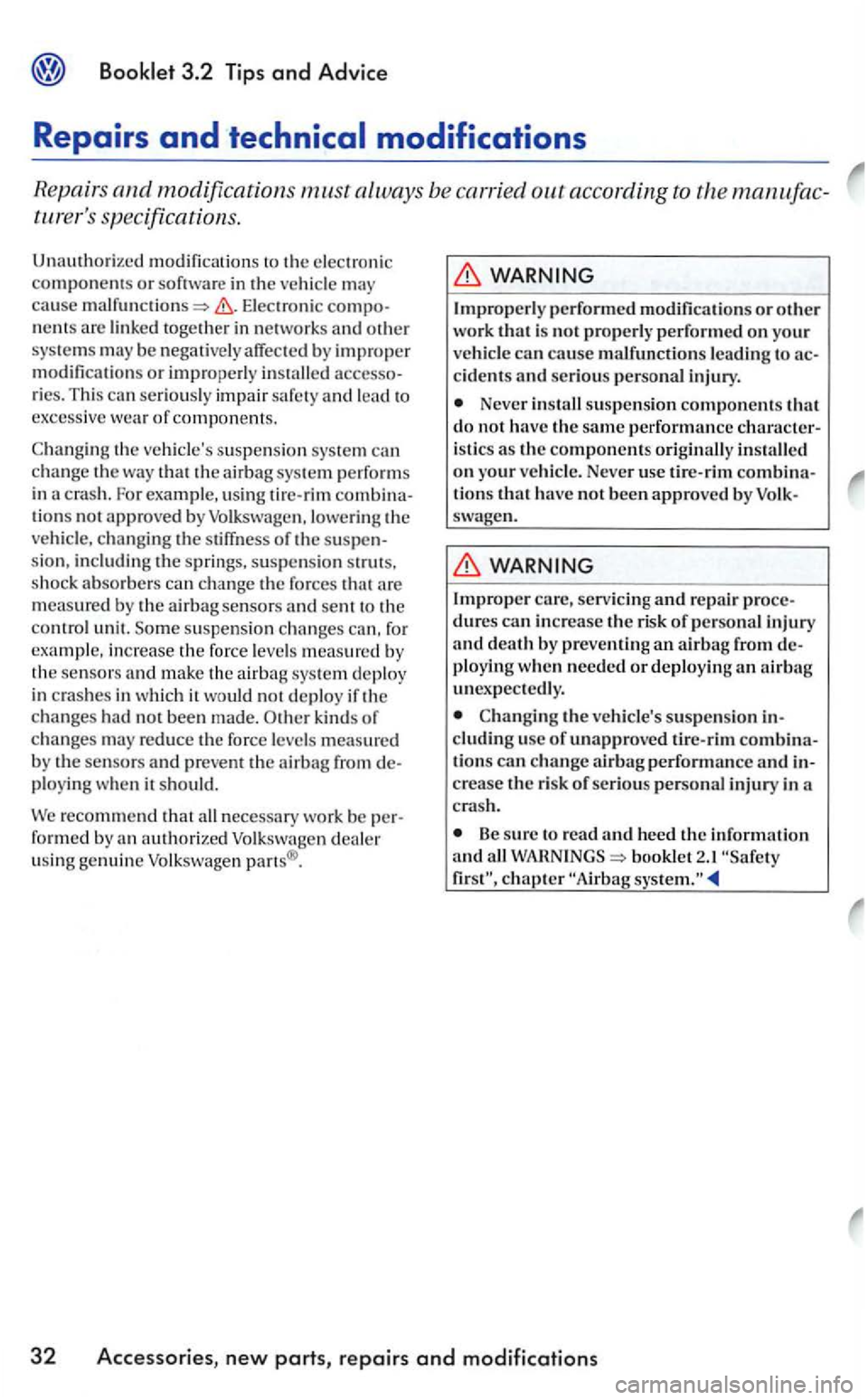
Booklet 3.2 Tips and Advice
Repairs and technical modifications
Repairs and modifications must always be carried out according to the
Ele ct ronic nent s are linked toge ther in network s and othe r
sys te m s m ay be negati vely affe cte d by im proper
modification s or improperl y ries. T his c an seriou sly impair safety and lead to
e xces sive wear of components.
th e su spension sys tem can change the way that the airbag sys tem perform s
in a cra sh. Fo r example, using tir e- rim tion s not approved by Volk sw agen, low ering the ch anging the s tiffn ess of the the springs, su spension strut s,
s hock absorbers can change the forces tha t a re measure d by the airbag sensors and se n t to the contro l unit. Some su spension ch a nge s can. for
exa mpl e, increase the force leve ls measured b y the sensors and m ake the airbag sys tem deploy
in cras hes in whi ch it w ould not deploy if the changes had not been made. Other kinds of change s m ay reduce the force leve ls m easured
by the sensors and p reven t th e airbag from plo ying when it should.
We recommend that nece ssary work be
can cause malfunctions leading to
Never s u spension components that d o not have the sa me performance is tic s as the components install ed on your Never use tire-rim tions that have not been approved by swagen.
care, servic in g and repair dures can increase th e risk of personal injury and death by preve nting an airb ag from ploying w he n needed or deploying an airbag unexpectedly.
the suspen sion cluding use o f unapproved tir e-rim tions change a irbag performance and
Be sure to read and heed the inf ormation and all bookle t chapter
32 Accessories , new parts, repairs and modifications
Page 320 of 444
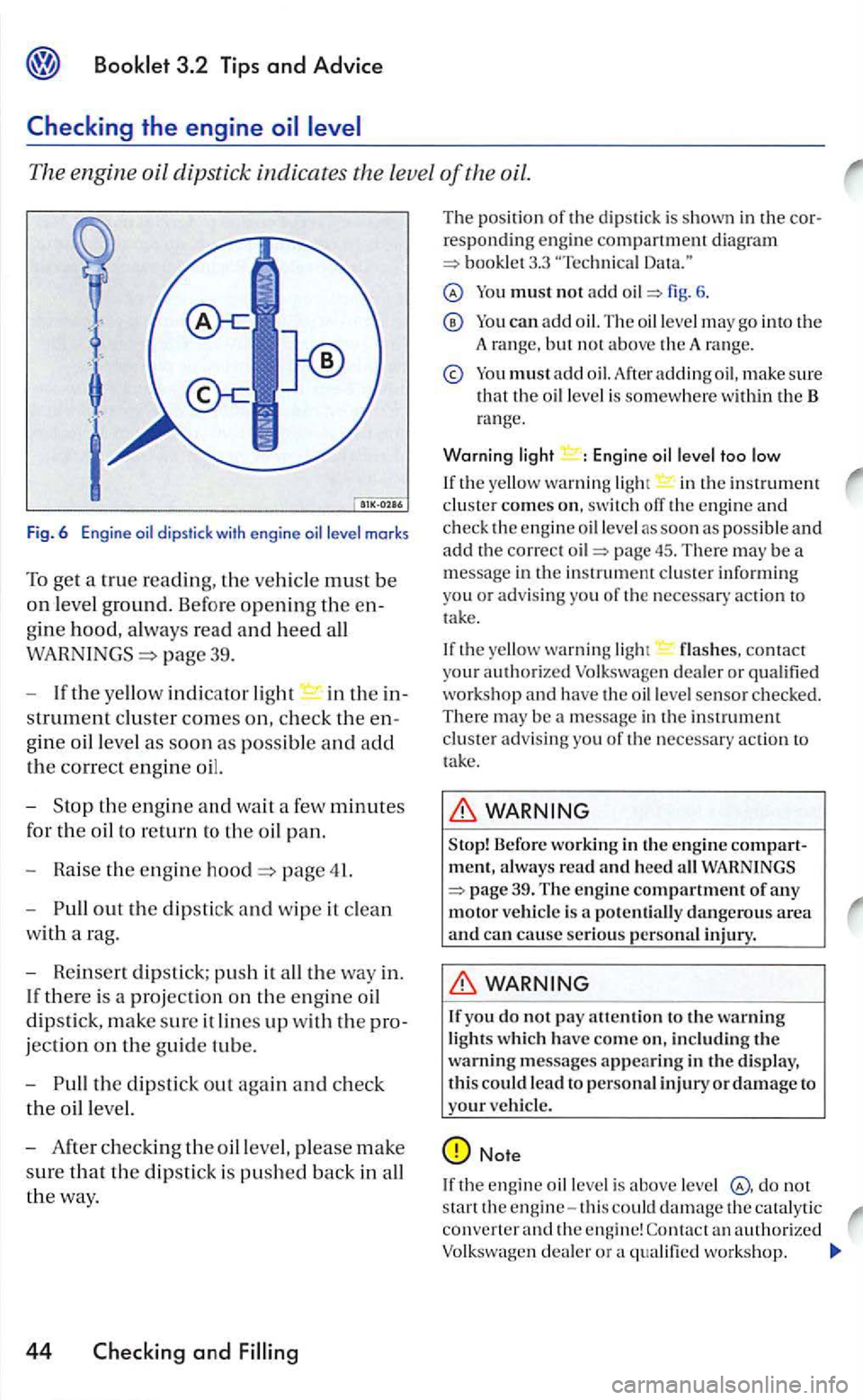
The engine oil dipstick indicates the leve l of the oil.
Fig. 6 E ngine level marks
To get a true reading, the ve hicl e must be
on leve l ground. Before opening the en
gine hood, always read and heed all
page 39.
If the yellow indicator light in th e in-
s
trument cluster comes on, check the e n
gine o
il leve l as soon as possible and add
the correct engin e oil.
the eng in e and wait a few minutes
for
the oil to return to the o il pan.
p a ge 41.
out the dipstic k and w ip e it clean
w ith a rag.
Rein se rt dips tick; push it all the way in.
If
ther e is a projection on the en gin e oi l
dipstick, make sure it lines up with the pro
jection on the guide tube.
the dipsti ck out aga in and ch eck
the o il l evel.
You must not add fig. 6 .
You can add
You m ust add oil. adding oil, make sure the level is somewhere within t h e B range.
Warning light : Engin e oi l level too low
If the yellow warn in g ligh t in the instrument cluster comes on, switc h ofT the engine and check the engine level as soon as possible and add the correct page 45. There may be a message in the instrumem cluste r informing you or advis ing you of the necessary action to
take.
If the yello w
warning ligh t flashes, contact your authorized Volkswa gen dealer or qualified workshop and have the oil leve l sensor checked. There be
WARN IN G
Before workin g in th e e ng in e compartm ent, always read and heed 39. T he engin e compartment of any motor vehicl e is potentiall y dangerous are a and can cause serio us personal injury.
WARN ING
If you do not pay attentio n to the warning light s which ha ve com e o n, incl ud in g the warning messages appearing in the d isplay, this could lead t o personal in juryordamage to
your ve hicle.
Note
If the engine oil is above level not
start the engine-this could damage the catal ytic converter and the engi ne!
Page 339 of 444
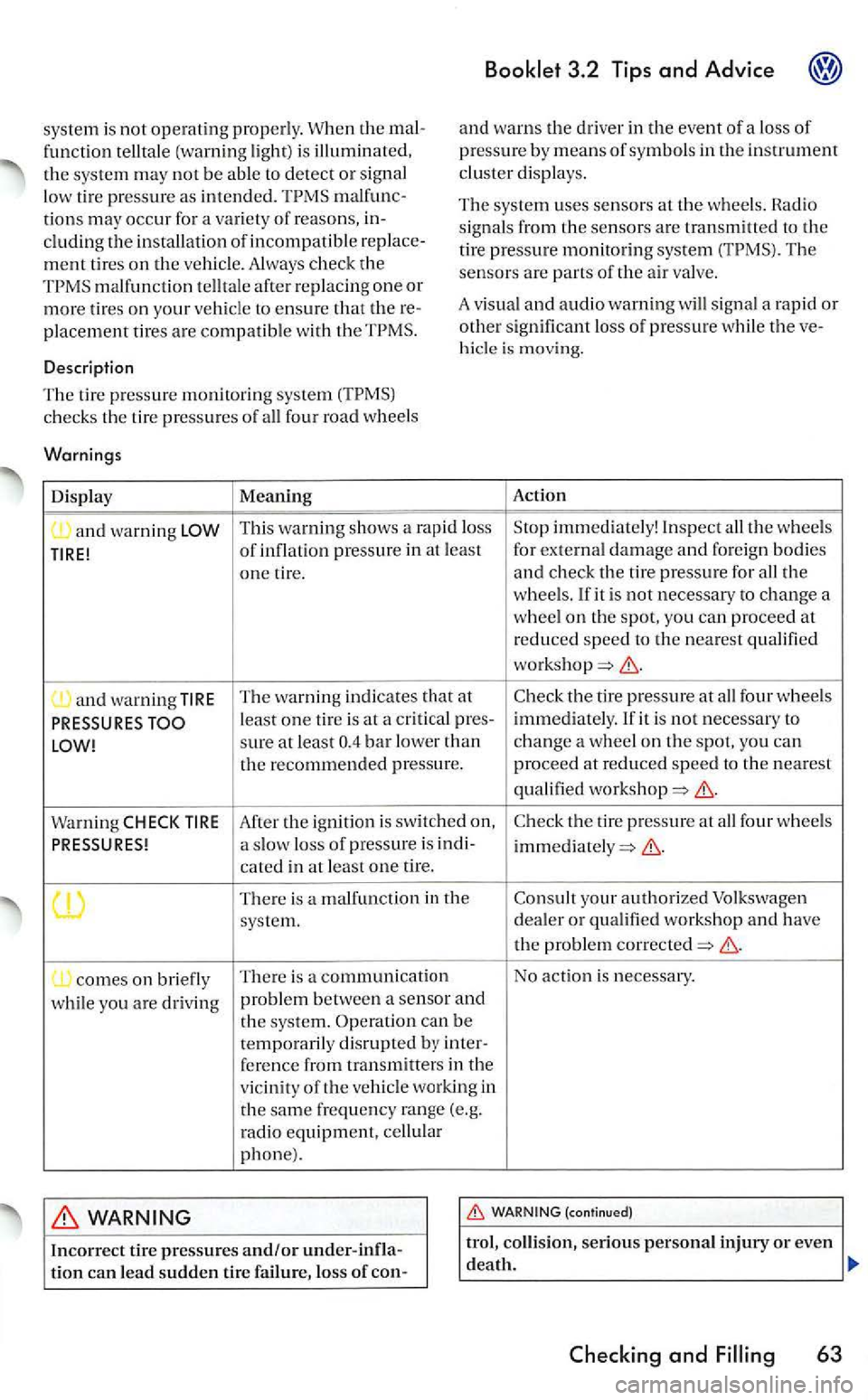
syste m is not operating properly. When the malfunct ion telltale (warning light) is illuminat ed, the system may not be able to detect or signal
low tire pressure as intended. malfunc
tions may occur for a var iety of reasons, including the installation of incompatible replacement tires on the vehicle. Always check the
and warns the driver in the event of a lo ss of pressu re by means of symbols in the instrument cluster dis plays.
Descri
ption
The system uses sensors at th e whee ls . Rad io
signals from the sensors are transmitted to the tire pressure monitoring system Th e sensors are parts of the air valve.
A visua l
and audio warning will signal a rapid or other significant loss of pressure while the ve
hicle is moving .
The tir e pressure monitorin g system
This warning shows a rapid loss Stop immediately! Inspect all the wheels
T
IRE! of i nflation pressure in at least for e
xt ernal damage and for eign bodies
one tire. and check the tire pressure for all the wheels. If it is not necessary to change a
w heel on th e spot, you can proceed at reduced speed the nearest qualified
and warnin g TIRE The warn ing indicates that at Chec
k the tire pressure at all fou r whee ls leas t one tire is at a criti ca l pres- immediately. If it is not necessary to sure at least
Warning CHECK TIRE After the ig n it ion is switched Check the tire pressure at all fou r wheels a slow loss of pressure is indi-
There is a malfunct ion in the Consult your a uthorized Volkswagen
system. dealer or qualified workshop and have
the p ro ble m corrected
comes on briefly There is a communica tion No action i
s necessaty.
while you are
driving problem between a sensor and the system. Operation can be temporarily di srupted by inter-
f ere nce from transmitters in the
v icinity of the vehicl e working in
t h e same frequency range (e.g.
rad io equipment, cell ula r phone).
WARNING
Checking and 63
Page 340 of 444
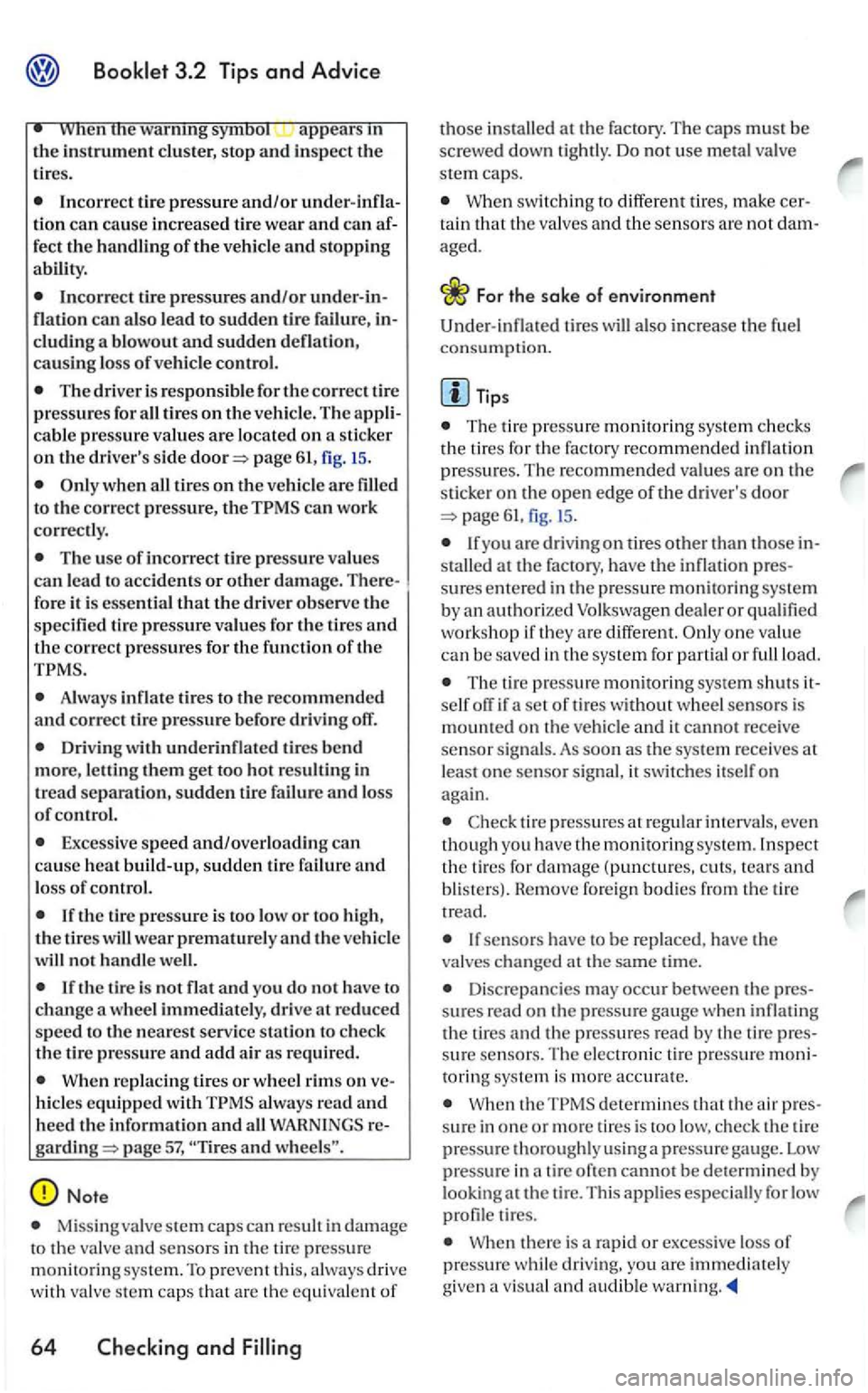
the instrument cluster, stop and insp ec t th e
tir es.
can also lead t o sudden tire failur e, in
cluding a blowout and sudden deflati on, causing loss of ve hicle control.
The driv er i s responsible for the correct tire pressures fo r all tire s on the vehicl e. Th e appli
cable pressure valu es are locat ed on a sticker on the driver' s sid e page 61, fig . 15 .
w hen all on the ve hicl e are filled
to the correct pressure, th e can work
corre ctly.
A lways inflat e tire s to the recomme nd ed
and correct tire pres sure before driving off.
in tread separa tion, sudden
Excess ive speed and/overloadin g can
ca use heat build-up , sudden tir e failur e and lo ss of control.
If th e tire is no t flat and you do not have to change a w hee l immediate ly , drive at reduce d
s peed to tJ1e neares t se rvic e statio n to ch ec k the tir e press ure and add air as req uired.
Whe n r epl acing tir es or wheel rim s on ve
hicles equipped with always read and heed the information and all repage 57, and
Note
M iss in g va lve stem caps can result in damage
to the valve and senso rs in the tire pressure
monitor ing sys tem. To preve nt thi s. a lways drive
wit h valve stem caps that are th e equiva le nt of
64
tho se installed
When switc hin g to diff erent tires, make cer
tain that the valves and the se nsors are not dam
ag ed .
For the sake of environment
Unde r-inflated tires will a lso in crease the fu el
consumption.
Tips
The tir e press ure mon itoring system ch ecks
th e tir es for the fac to ry recommend ed in flat ion pressures. The recommended val ues are on th e sticker on the o pen edge of th e driver's door
61, fig.
you are driving on tires other than those in
s talled at th e factory, have the inflati on pres
s ure s entered in the press ure monitor ing sys tem
by an authorized Vol kswage n dea ler or qua lified
works hop if they are different.
Th e tire pressure monitor ing system sh uts itself off if a set of tir es without whee l sensors is
mounted on th e veh icle and it cannot receive senso r sig nals. As soon as the syste m rece ives at
lea st one se nsor signa l, it switches itself on
again.
tir e pressures at regu lar int ervals, even
though you have the monitoring system. In spec t
th e
tires for damage (punctu res , cuts, t ea rs a nd
blis ter s). He move foreig n bodi es from the tir e
tread.
senso rs have to be rep laced, have the valves ch anged at th e sa me tim e.
Disc repancies may occur between the pres
sures read on the press ure ga uge when inflating the tires and th e pressures read by the tire pressu re sensors. The electro nic tire pressure monitoring system is m ore accurate.
When deter min es tha t the air pres
s u re in o ne or more tires is too low, ch eck the tire
pressure thoroughly using a pressu re Low pressure in a tire often cannot be determi ned by
looking at the tire. This applies especially for low
profile tires.
When there is a rap id or excessi ve loss of pressure while driving. you are immediately
g iven vis u a l and aud ible warn ing .
Page 341 of 444
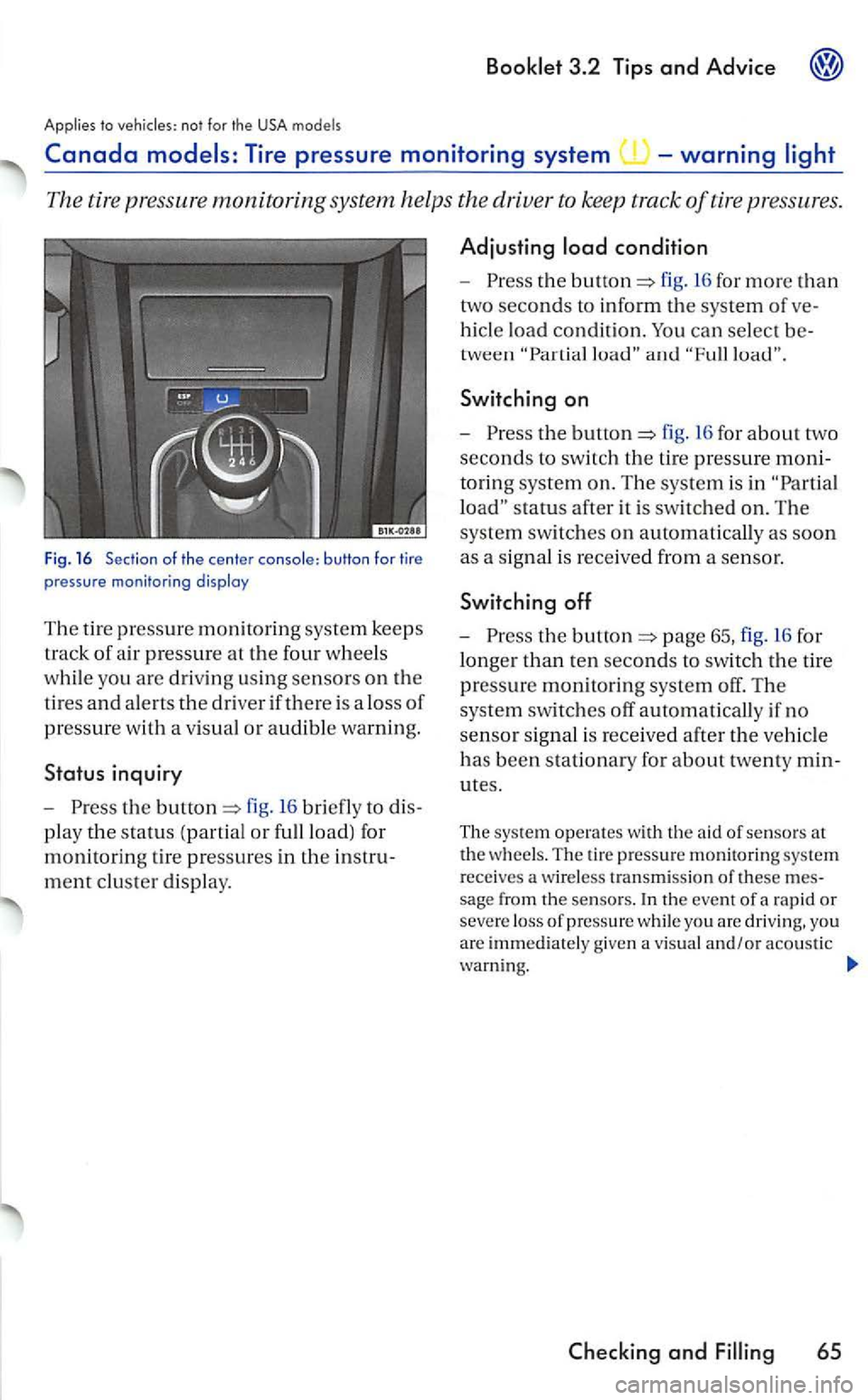
to the USA models
The tire pressure monitoring system helps the driver to keep track of tire pressures.
Fig. 16 Section of the center console: button for tire
p ressure monitoring disploy
T he tir e pressure monitoring system keep s
track
of air pressure at the four wheels
w hil e yo u
are driving using sen so rs on th e
tir
es and alerts the dri ver if th ere is a lo ss of
pressure with a visual or audibl e warning.
Status inquiry
-
play the status (partial or full load) for
m
onito ring tir e press ures in the
ment clu ster display.
Adjusting
the fig. 16 for more than
two seconds to inform th e system of
hicle load condition.
Switching on
-the fig. 16 for about two
seconds to switch the tire press ure
tori ng syste m on. The system is in
after it is switched o n. The
system
switches on autom atic ally as soon
as a sig nal is receive d from a sensor.
Switching off
-page 65, fig. 16 for
lo nger than te n seconds to switch th e ti re
pressure monito ring system off. The
system switches off automatically if no
sensor sig na l i s received aft e r th e vehicle
has been statio nary for about twenty
th e a id of se nso rs at t h e w heels . The tir e pressure monitoring syste m
rece ives a wireless transmissio n of these sage from the senso rs. In the event of a rapid or severe loss of pressu re wh ile yo u are driving, you are immediately given a visual and/or acoust ic
warning .
65
Page 343 of 444
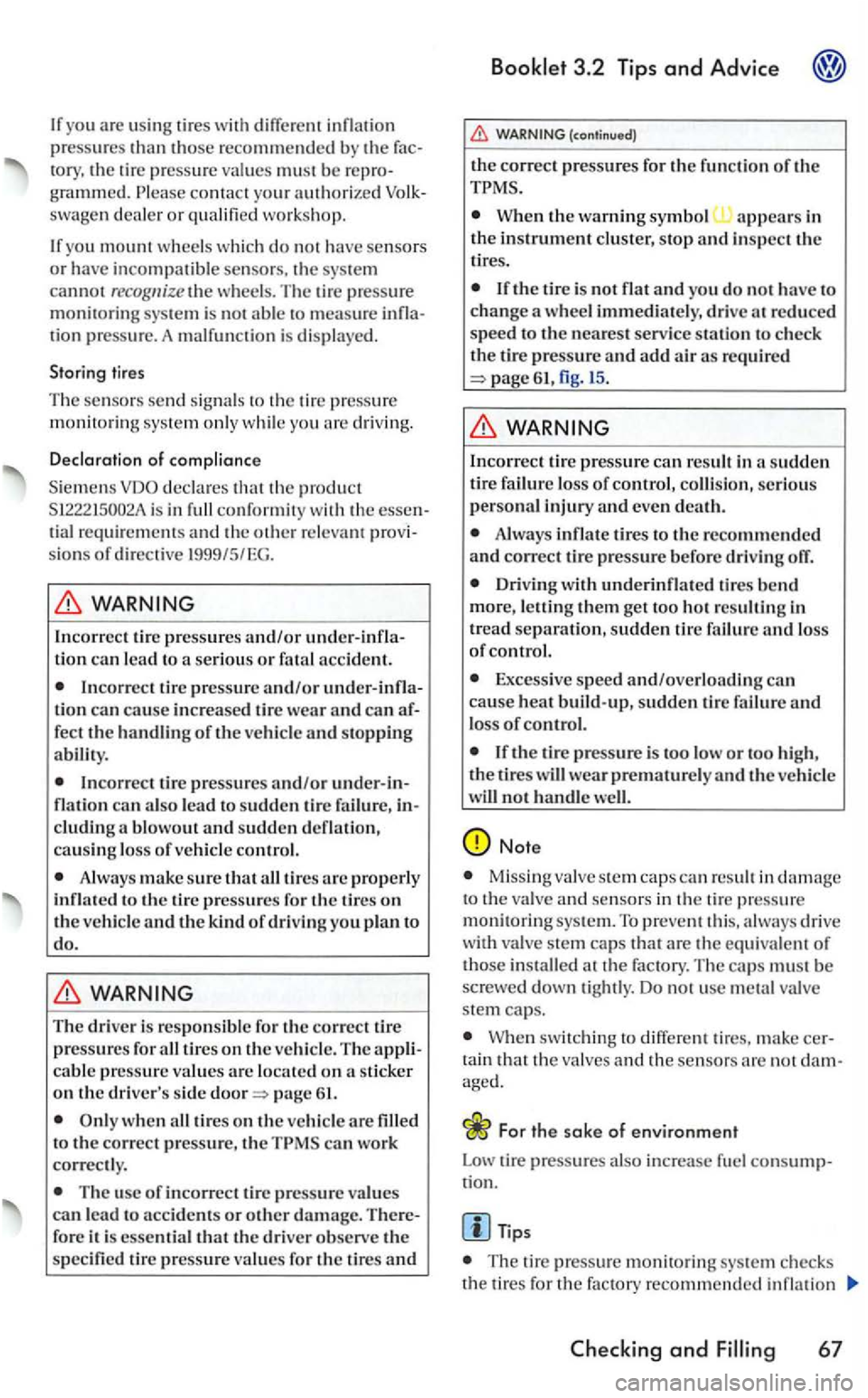
you are using tires w ith inflatio n
p ressures than those recommended by the tory, the tir e press ure val ues must be re programmed. swagen dealer or q ualified workshop.
you mount wheels whic h d o not have sen sors or have incompatible sensors . th e sys tem cannot recognize the wheel s. The tir e pressure monitoring sys te m is not abl e to measure infla
tion press ure. A malfun ction is di sp la ye d.
S t
oring tires
T he se nsors se nd signa ls to t h e tir e press ure
monitori ng sys te m only whi le you arc driv ing .
D eclaration of complianc e
Siemens declares that the product is in full c onfo rmit y w ith the essential requi rements and the other re levant prov i
sio ns of directi ve 19 99/5/EG.
WARNING
In correc t tire pressures and/or unde r- inflati o n can lead t o
an d can
Incorrect t ire p ressures and/o r under-i n
flatio n ca n also lead to sudden tir e failure, bl owout and sudden d eflati on, causing loss of ve hicl e control.
Always make sure that a ll tires are properl y
inflat ed t o tire press ures fo r th e tires o n
t h e vehicl e and the kind of driv in g yo u plan to
do.
WARNING
The d rive r is responsib le for the correct tire
press ures for all tires on th e ve hicle. The cable pressure values arc loc ate d on sticke r
o n the dri ver's sid e page 61.
correctly.
The use of in correct tire pressure values can lead to acci den ts or other damage. There
f o re it i s esse ntial that the d river observe the
s p ecified tire p ressure va lues fo r the tires an d
Booklet 3.2 Tips and Advice
WARNI NG (continued)
the correc t pressures fo r the functi on of the
W hen the
the ti re is not flat and you do no t have to
c h an ge a w heel immed ia tely, drive
required fig. 15.
WARNING
Incorrect tire pressure can result in sudde n
t ire failur e loss of control, co llisio n, seri ous
personal i njury an d even death.
A lways in flat e tires to the recommended and correct tire pressure before dri ving
D rivi ng with unde rinfl atc d ti res b end m ore, le ttin g them get too h o t res ulting in tread sep aration, sudden tire failure and loss
o f co ntrol .
Exces sive speed and/ overloading can cause heat build-up , sudden tire fa ilure a nd
l oss of control.
not handl e we ll.
Missin g valve ste m caps can resu lt in damage to th e va lve and sensor s in the tire pressure mon itorin g sys te m. To pre vent t his, alwa ys dri ve
with valve stem caps that are the equi valent of th ose insta lled va lve
s te m caps.
Whe n switc hin g to t a in that the va lve s and the sensors not aged.
For the sake of environment
Low tire pressures also increase fuel consump
tion.
The tire pressu re monitoring syste m checks
th e tires for the fac tory recommend ed inflation